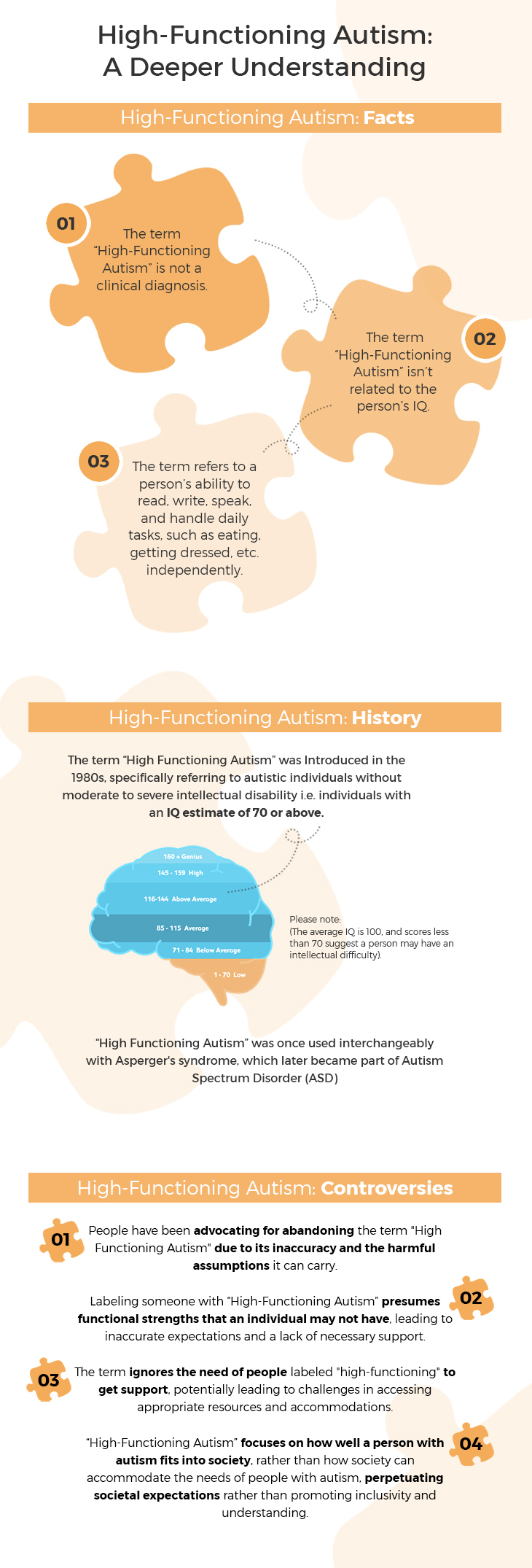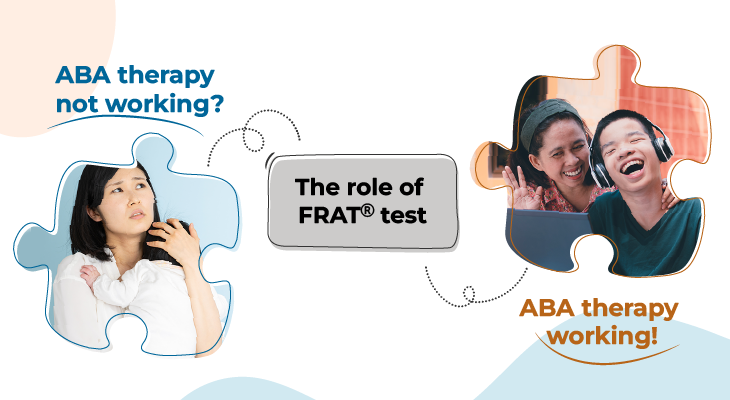The term “high-functioning autism” is one of the most widely used terms within the autism field. It is commonly heard in clinics, schools, and even in the mainstream media. Interestingly, the term “high-functioning autism” is not an official medical diagnosis, and has never been included in the diagnostic manuals.
The Diagnostic and Statistical Manual of Mental Disorders, Fifth Edition (DSM-5) defines autism as a spectrum disorder with three levels of severity. Level 1 is the least severe, with people requiring the least support, and Level 3 is the most severe, with people requiring the most support.
High-functioning autism is a term used to describe people with autism who would fall into Level 1 of the severity scale. This means that they have mild to moderate autism symptoms and may need some support in certain areas, such as social communication or repetitive behaviors, but they are generally able to live independently and function well in society.
This comprehensive guide explores the term “high-functioning autism” in detail, including its history and current day usage. The blog also includes signs & symptoms of high-functioning autism in children as well as the treatment options.
High functioning autism: the history, the controversy and the meaning today
The history
The term high-functioning autism first appeared in the 1980s, specifically referring to individuals without moderate to severe intellectual disability i.e. individuals with an IQ estimate of 70 or above. [1] (The average IQ is 100, and scores less than 70 suggest a person may have an intellectual difficulty).
In the past, the term “high-functioning autism” was also used interchangeably with Asperger’s syndrome because people with Asperger’s syndrome are less likely to have language issues and fewer noticeable signs of autism. This association became stronger in 2013, when the American Psychiatric Association grouped Asperger’s syndrome into autism spectrum disorder (ASD). Over time, “high functioning” became a term synonymous with expectations of greater functional skills and better long-term outcomes, despite contradictory clinical observations. [2]
Many children and young people with autism may have an appropriate IQ for their age but still struggle with everyday skills like getting themselves to school, navigating public transport, or communicating at the same level as their peers.

The term “high-functioning autism” first appeared in the 1980s, but its meaning has evolved over time. It was once used interchangeably with Asperger’s syndrome, but is now more commonly used to describe people with autism who have mild to moderate symptoms.
#highfunctioningautism #autismspectrumdisorder #autismawareness
The controversy surrounding the term high-functioning autism
How well you function in everyday life is not determined by your IQ, but by your adaptive skills, which are the practical skills and behaviors you need to function. Adaptive skills can include communication (both verbal and nonverbal), social interaction, and domestic and independent living skills (such as taking public transportation, preparing food, and managing self-care).
Since the interpretation of high-functioning is a subjective call, there are disagreements about who is high-functioning and who is not. Based on cultural norms, the term high-functioning has been used when a person:
- Receives their autism diagnosis as an adult, or relatively late in childhood
- Does well in school or at work
- Does not have language differences or clear developmental delays
- Can live independently
Due to its inaccuracy and the harmful assumptions it can carry, many people have long advocated for abandoning the term “high-functioning autism.” Several problems with the term have been cited by opponents, who offer many arguments such as:
- The term presumes functional strengths that an individual may not have; and It may ignore the need of people labeled “high-functioning” to get support.
- Some people use the term to downplay or dismiss the concerns of autistic adults about how society treats autistic children.
- The term focuses on how well a person with autism fits into society, rather than how society can accommodate the needs of people with autism.

The term “high-functioning autism” is controversial, with some arguing that it is inaccurate and harmful, while others maintain that it is useful for describing people with autism who have mild to moderate symptoms. It is important to be aware of the different perspectives on this term and to use it respectfully.
#highfunctioningautism #autism #autismawareness #autismacceptance #autismpride #autismspectrumdisorder #autismadvocacy
The meaning of “high-functioning” today
The term high-functioning autism isn’t related to the person’s IQ. Today, high-functioning autism means that a person is able to read, write, speak, and handle daily tasks, such as eating and getting dressed independently. Despite having symptoms of autism, their behavior doesn’t interfere too much with their work, school, or relationships.
Do remember that “high-functioning autism” is not a clinical diagnosis. Therefore, it is important to use the term “high-functioning autism” carefully. If you are unsure whether or not to use the term, it is best to err on the side of caution and avoid using it.

Download Download & share this infograph in your network [Free Download]
Signs and symptoms of high-functioning autism in children
Although the term “high-functioning” can be used to describe a wide range of autistic people with different abilities and needs, there are some common symptoms that may be present.
- Social challenges
Like all people on the autism spectrum, people who are high functioning also have a hard time with social interaction and communication. Because they may not be able to easily understand social cues, people with high-functioning autism may have difficulty making friends and may be perceived as socially awkward.
People with high-functioning autism may sometimes focus more on themselves than on others. This can be challenging for neurotypical people, who may perceive them as talking about themselves too much, interrupting others, or having difficulty paying attention in conversations - Emotional sensitivity
People with high-functioning autism are often very sensitive to emotions and even small things, like loud noises, changes in routine, or spilling of juice, can cause intense emotional reactions and upset them for the rest of the day.
The fact that high functioning autism is challenging to detect can make such children frequently suffer extreme emotional sensitivity which can also lead to intense sorrow and isolation. - Physical sensation sensitivity
Most children with autism spectrum disorder (ASD) have difficulty processing sensory information, but high-functioning autistic people tend to be particularly sensitive to physical sensations such as:- loud noises
- uncomfortable clothing
- physical touching by another person
- bad smells or tastes
These physical sensation challenges may cause a child to be easily distracted which can be overwhelming. For example, a loud noise or bad smell that does not bother neurotypical children may be very disruptive and upsetting for a high-functioning autistic child, leading to emotional distress and possibly a meltdown.
- Focus on repetitiveness
High-functioning autism is characterized by a strong interest in a specific subject or activity. For example, the child could be interested in dinosaurs, trains, or space. These obsessions cause negative impact when they interfere with social interactions or quality of life. However, it can be also used to improve the child’s understanding of the particular subject. For example, a child who is interested in dinosaurs could be encouraged to visit a museum, read books about dinosaurs, or watch documentaries about dinosaurs. - Focus on routines and restrictive habits
Children with high-functioning autism often have a strong preference for routine and repetition. This can include things like:- eating the same meal every day
- wearing the same outfit every day
- brushing the teeth for exactly 2 minutes
- getting exactly 8 hours of sleep each night
- Perceived inattention due to lack of eye contact
Children with high-functioning autism may have difficulty making eye contact with their parents or caregivers and responding in the way that neurotypical children do. For example, when most young children find something funny, they look at their caregivers to see if they are also amused, signaling their social awareness. If a child fails to look to their caregiver for shared interest, it may be a sign that they lack this particular social skill. - Depression or Anxiety
People with high-functioning autism (HFA) can experience depression and anxiety. In fact, studies have shown that Anxiety disorders are disproportionately prevalent among adolescents with autism spectrum disorder, affecting approximately 42% of this population. This rate is more than double that of adolescents without developmental disorders, where it is only around 20% [3]. The risk factors for anxiety and depression include:- Difficulties with social interaction and communication: People with HFA may have difficulty forming and maintaining relationships, which can lead to feelings of isolation and loneliness.
- Sensory sensitivities: People with HFA may be more sensitive to sights, sounds, smells, tastes, and textures, which can lead to stress and anxiety.
- Executive functioning challenges: People with HFA may have difficulty with planning, organizing, and problem-solving, which can lead to stress and frustration.
- Genetic factors: There is some evidence that genes play a role in the development of both autism and depression.
Diagnosis of high-functioning autism in children
Since autism is a neurodevelopmental disorder, it is not a disease in the traditional sense because it is not caused by pathogens or abnormal cell growth. Therefore, when it comes to autism, the diagnostic processes employed differ significantly from those used for other medical conditions.
As per CDC, autism can sometimes be detected at 18 months or younger and by the age of 2, a diagnosis by an experienced professional can be considered reliable. Early diagnosis of autism spectrum disorder (ASD) is essential to ensure that children receive the services and support they need to thrive.
If you suspect your child to have high-functioning autism or may be on the autism spectrum, we recommend you to read our guide Decoding Autism: Essential Tests and Key Indicators You Can’t Afford to Ignore
Treatment for high-functioning autism in children
Treatment for high-functioning autism is tailored to the individual needs of the child, and your medical service provider can develop a plan that is right for your child. Usually, the management of high-functioning autism includes:
- Therapy:
- Occupational therapy
- Physical therapy
- Speech therapy
- Behavioral treatment:
- Applied Behavior Analysis (ABA)
- Social Skills Therapy
Conclusion
While the term “high-functioning autism” is still widely used, it is important to note that it is not an official medical diagnosis. It is a subjective term that can be used to make assumptions about people’s abilities that may not be accurate. One must be aware of its limitations and potential harms. Additionally, it can be used to dismiss the concerns of autistic people and their families. Ultimately, it is important to focus on the individual needs of each person with autism, regardless of their label.
Children with high-functioning autism may have difficulty with social communication, repetitive behaviors, and sensory processing. However, they are also able to learn and thrive with the right support. If you suspect that your child may have high-functioning autism, it is important to seek early diagnosis and intervention. Early intervention can help children develop the skills they need to reach their full potential.
For information on autism monitoring, screening and testing please read our blog.
References
- Ameli R., Courchesne E., Lincoln A., Kaufman A. S., Grillon C. (1988). Visual memory processes in high functioning individuals with autism | Journal of Autism and Developmental Disorders, 18, 601–615
- The misnomer of ‘high functioning autism’: Intelligence is an imprecise predictor of functional abilities at diagnosis
- Impact of anxiety disorders on quality of life of adolescents with autism spectrum disorder without intellectual disability




